Enhancing Energy Efficiency of Thermomagnetic Generators: A Comprehensive Study on Frequency and Heat Dissipation
Abstract
1. Introduction
2. System Design and Function
3. The Theory
3.1. Power Generation
3.2. Heat Dissipation
3.3. The Efficiency
4. Results and Discussions
4.1. Experimental and Validation
4.2. Analysis of Results and Implications
5. Conclusions
- ▪
- Coil Geometry: Optimal coil performance was achieved when the coil thickness was set at 2.5 mm.
- ▪
- Temperature Effects: Lower heat sink temperatures were found to enhance system performance. Additionally, the system exhibited improved operation when the heat source temperature closely approached the Curie point of the Gd material.
- ▪
- Heat Source–Sink Separation: The optimum distance between the heat source and heat sink was determined to be 8 mm, optimizing both frequency and heat dissipation, even though increasing the separation distance could lead to higher voltage magnitude.
- ▪
- Gd Disk Geometry: The geometry of the Gd disk significantly influenced the outcomes. For frequency considerations, the optimal Gd diameter was 16 mm, with a preference for the lowest possible thickness. In contrast, for maximizing heat dissipation rate, the best combination was found to be a Gd thickness of 2 mm and a diameter of 10 mm.
Author Contributions
Funding
Data Availability Statement
Acknowledgments
Conflicts of Interest
References
- Ali, S.F.; Friswell, M.I.; Adhikari, S. Analysis of Energy Harvesters for Highway Bridges. J. Intell. Mater. Syst. Struct. 2011, 22, 1929–1938. [Google Scholar] [CrossRef]
- Pedchenko, A.V.; Meyer, J.J.; Barth, E.J. Assessing Stability and Predicting Power Generation of Electromagnetic Vibration Energy Harvesters Using Bridge Vibration Data. IEEE/ASME Trans. Mechatron. 2016, 22, 269–279. [Google Scholar] [CrossRef]
- Armstead, J.R.; Miers, S.A. Review of Waste Heat Recovery Mechanisms for Internal Combustion Engines. J. Therm. Sci. Eng. Appl. 2014, 6, 014001. [Google Scholar] [CrossRef]
- Elahi, E.; Al-Kahtani, A.A.; Dastgeer, G.; Aftab, S.; Aziz, J.; Iqbal, M.W.; Manzoor, M.; Jeong, J.; Suleman, M.; Ahmed, B.; et al. Recent Advances in Thermomagnetic Devices for Spin-Caloritronic Phenomena. Appl. Mater. Today 2023, 32, 101846. [Google Scholar] [CrossRef]
- Du, L.; Shi, G.; Zhao, J. Review of Micro Magnetic Generator. Sens. Transducers 2014, 176, 1. [Google Scholar]
- Shi, L.; Tao, W.; Zheng, N.; Zhou, T.; Sun, Z. Numerical Study of Convective Heat Transfer and Particle Distribution Subject to Magneto-Static Field in a Square Cavity. Int. J. Therm. Sci. 2023, 185, 108081. [Google Scholar] [CrossRef]
- Torre, S.; González-González, J.M.; Aguado, J.A.; Martín, S. Optimal Battery Sizing Considering Degradation for Renewable Energy Integration. IET Renew. Power Gener. 2019, 13, 572–577. [Google Scholar] [CrossRef]
- Champier, D. Thermoelectric Generators: A Review of Applications. Energy Convers. Manag. 2017, 140, 167–181. [Google Scholar] [CrossRef]
- Saha, N.; Kuehne, A.; Millward, J.M.; Eigentler, T.W.; Starke, L.; Waiczies, S.; Niendorf, T. Advanced Radio Frequency Applicators for Thermal Magnetic Resonance Theranostics of Brain Tumors. Cancers 2023, 15, 2303. [Google Scholar] [CrossRef] [PubMed]
- Bell, L.E. Cooling, Heating, Generating Power, and Recovering Waste Heat with Thermoelectric Systems. Science 2008, 321, 1457–1461. [Google Scholar] [CrossRef] [PubMed]
- Jangonda, C.; Patil, K.; Kinikar, A.; Bhokare, R.; Gavali, M. Review of Various Application of Thermoelectric Module. Int. J. Innov. Res. Sci. Eng. Technol. 2016, 5, 3393–3400. [Google Scholar]
- Zhili, T.; Dongjiao, Z.; Yong, L.; Feng, Y. Modelling and Control Strategy of a Distributed Small-Scale Low-Temperature Geothermal Power Generation System. IET Renew. Power Gener. 2023, 17, 539–554. [Google Scholar] [CrossRef]
- Dan’Kov, S.Y.; Tishin, A.; Pecharsky, V.; Gschneidner, K. Magnetic Phase Transitions and the Magnetothermal Properties of Gadolinium. Phys. Rev. B 1998, 57, 3478. [Google Scholar] [CrossRef]
- Zverev, V.I.; Gimaev, R.R.; Tishin, A.M.; Mudryk, Y.; Gschneidner, K.A.; Pecharsky, V.K. The Role of Demagnetization Factor in Determining the ‘True’ Value of the Curie Temperature. J. Magn. Magn. Mater. 2011, 323, 2453–2457. [Google Scholar] [CrossRef]
- Kumar, V. Thermomagnetic cooling of current carrying micro-wire in ferrofluid: Two-phase approach. Int. J. Therm. Sci. 2023, 194, 108560. [Google Scholar] [CrossRef]
- Christiaanse, T.; Bruck, E. Proof-of-Concept Static Thermomagnetic Generator Experimental Device. Metall. Mater. Trans. E-Mater. Energy Syst. 2014, 1, 36–40. [Google Scholar] [CrossRef]
- Sandoval, S.M. On the Thermodynamic Efficiency of a Multiferroic Thermomagnetic Generator: From Bulk to Atomic Scale; University of California: Los Angeles, CA, USA, 2014. [Google Scholar]
- Chun, J.; Song, H.C.; Kang, M.G.; Kang, H.B.; Kishore, R.A.; Priya, S. Thermo-Magneto-Electric Generator Arrays for Active Heat Recovery System. Sci. Rep. 2017, 7, 41383. [Google Scholar] [CrossRef] [PubMed]
- Homadi, A.; Hall, T. Modeling a New Electrical Generator Utilizing Waste Heat and Magnetic Susceptibility. In Proceedings of the 2018 IEEE Texas Power and Energy Conference (TPEC), College Station, TX, USA, 8–9 February 2018. [Google Scholar]
- Griffiths, D.J. Introduction to Electrodynamics, 4th ed.; Cambridge University Press: Cambridge, UK, 2021. [Google Scholar]
- Cengel, Y.A.; Ghajar, A.J. Introduction and Basic Concepts. In Heat and Mass Transfer Fundamental and Applications; McGraw-Hill Education: New York, NY, USA, 2015. [Google Scholar]
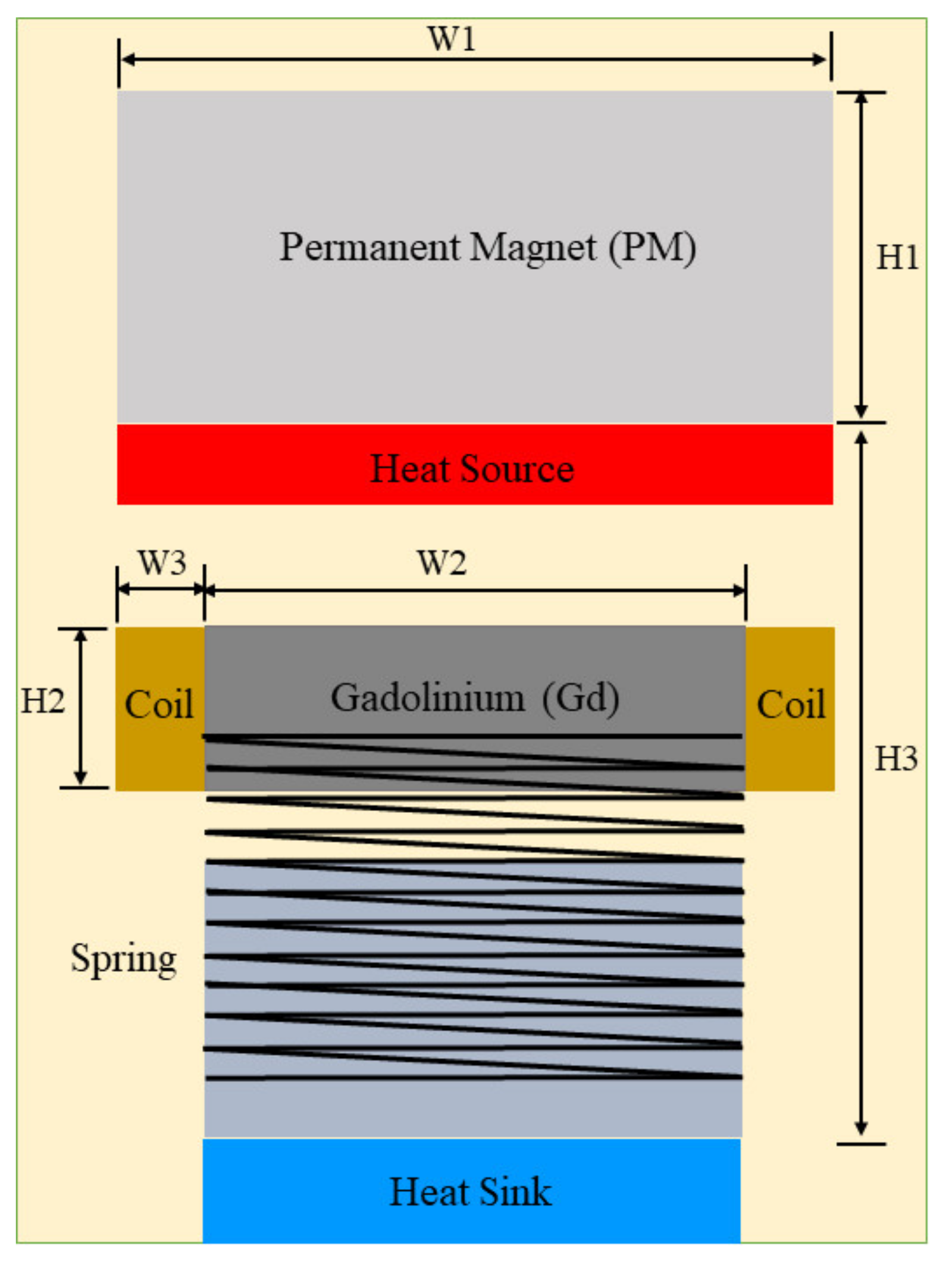
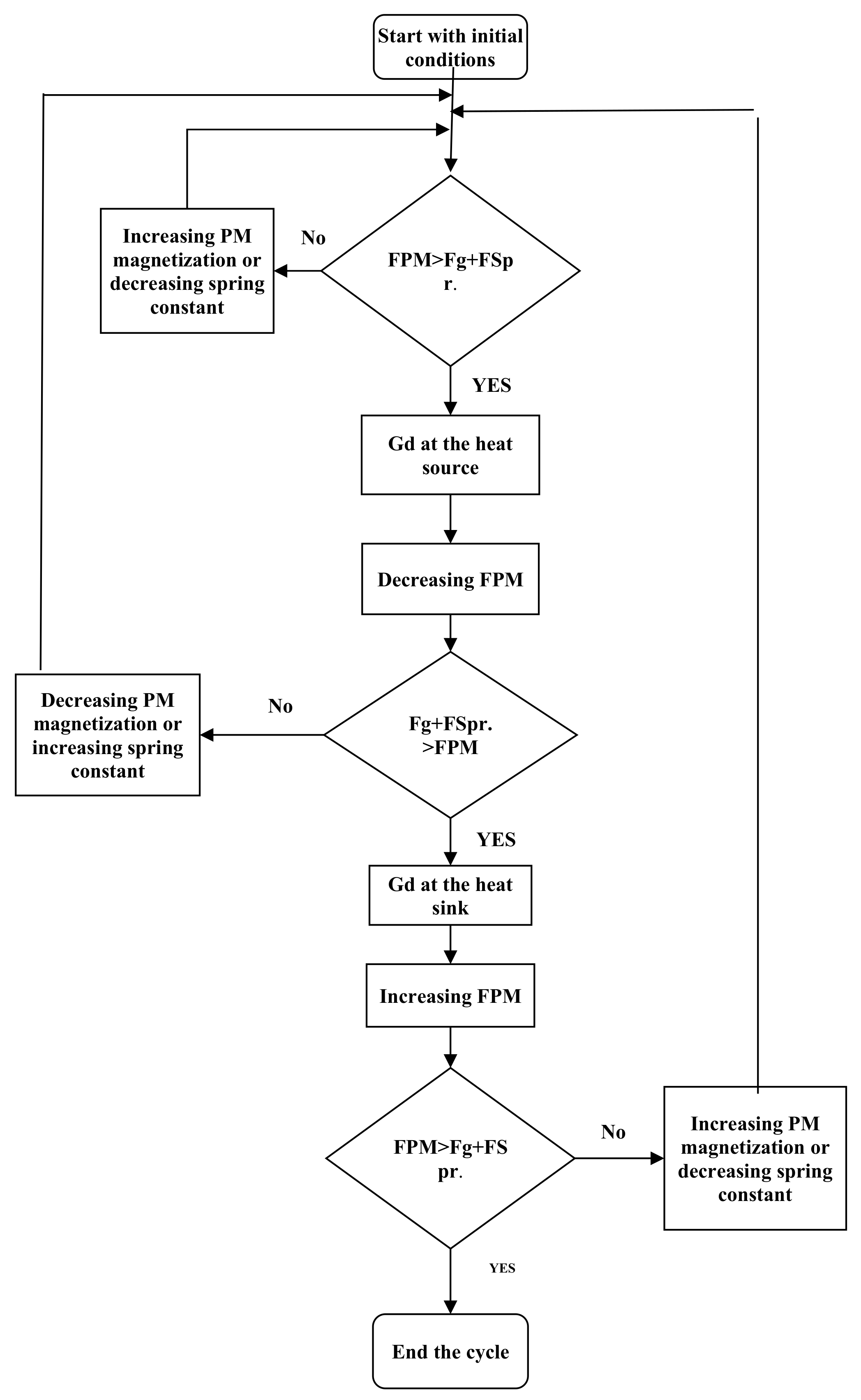
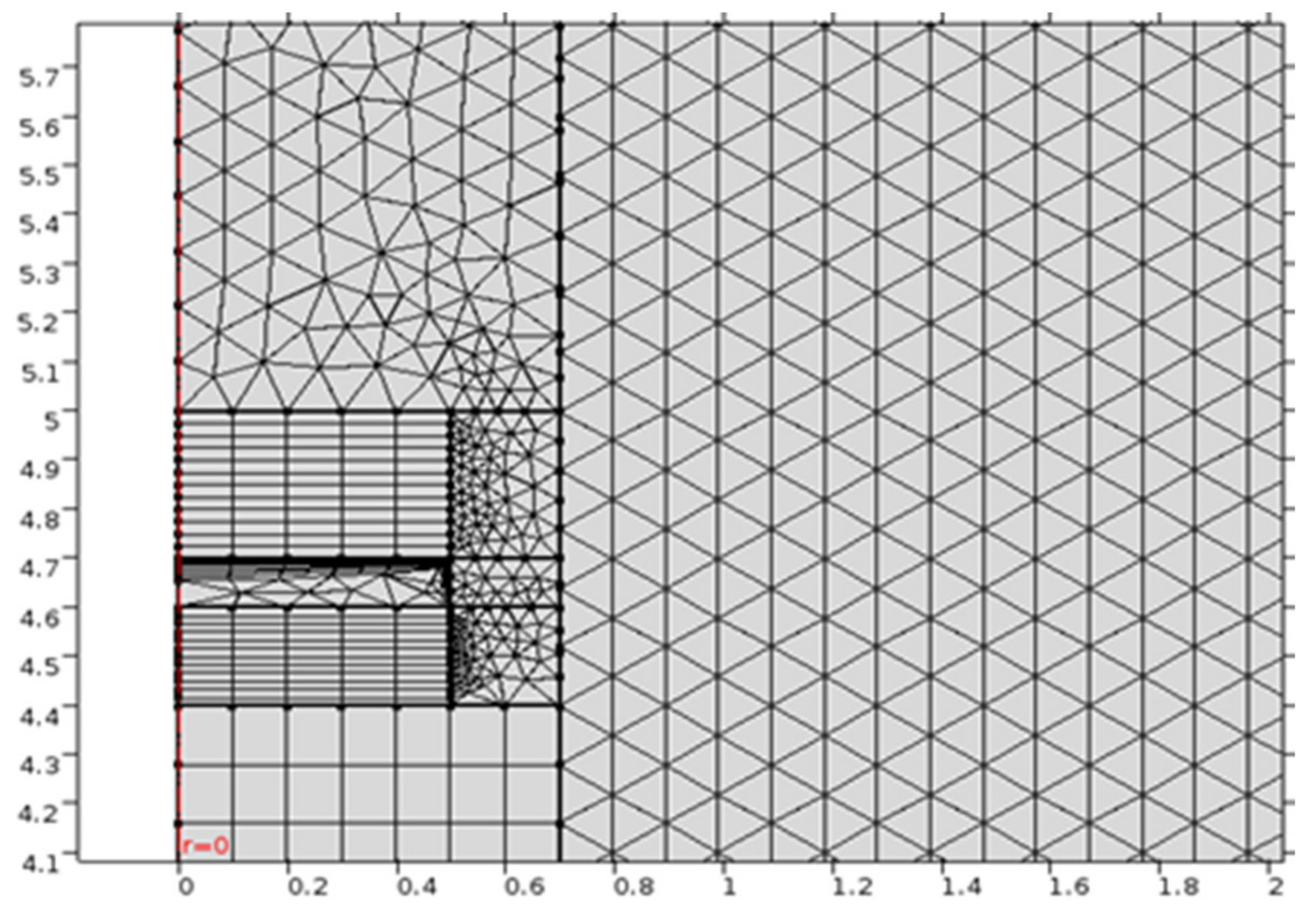

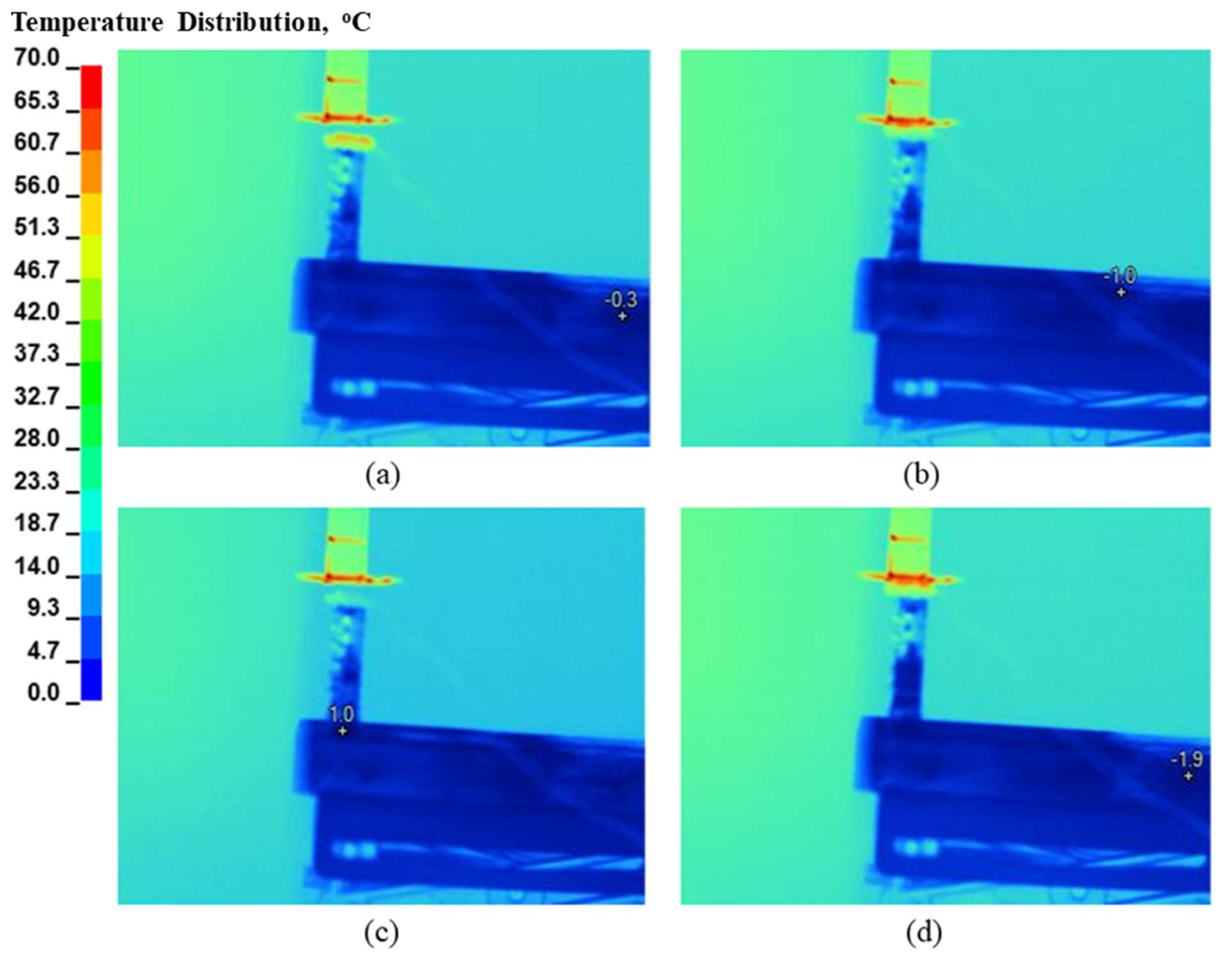





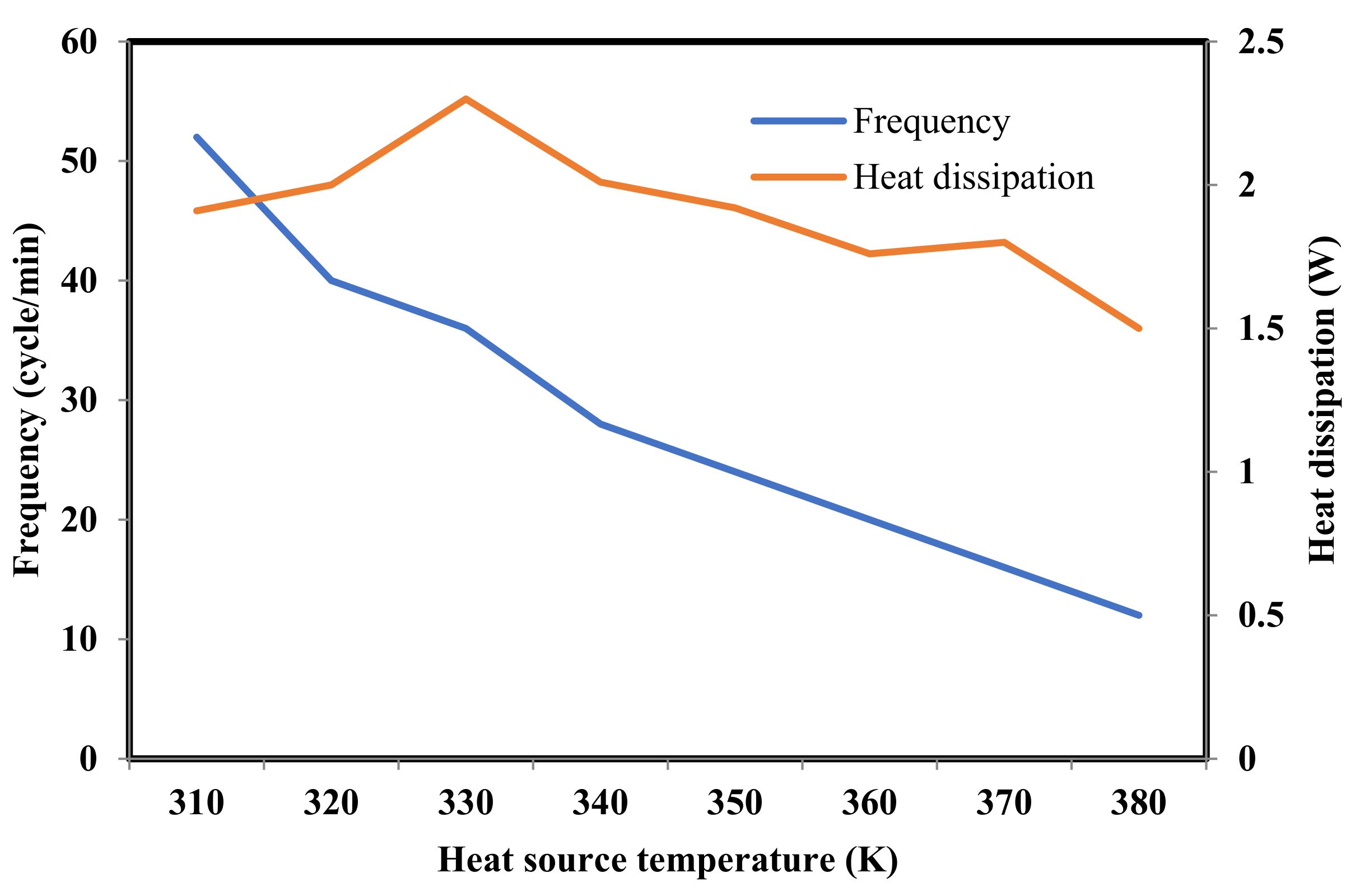

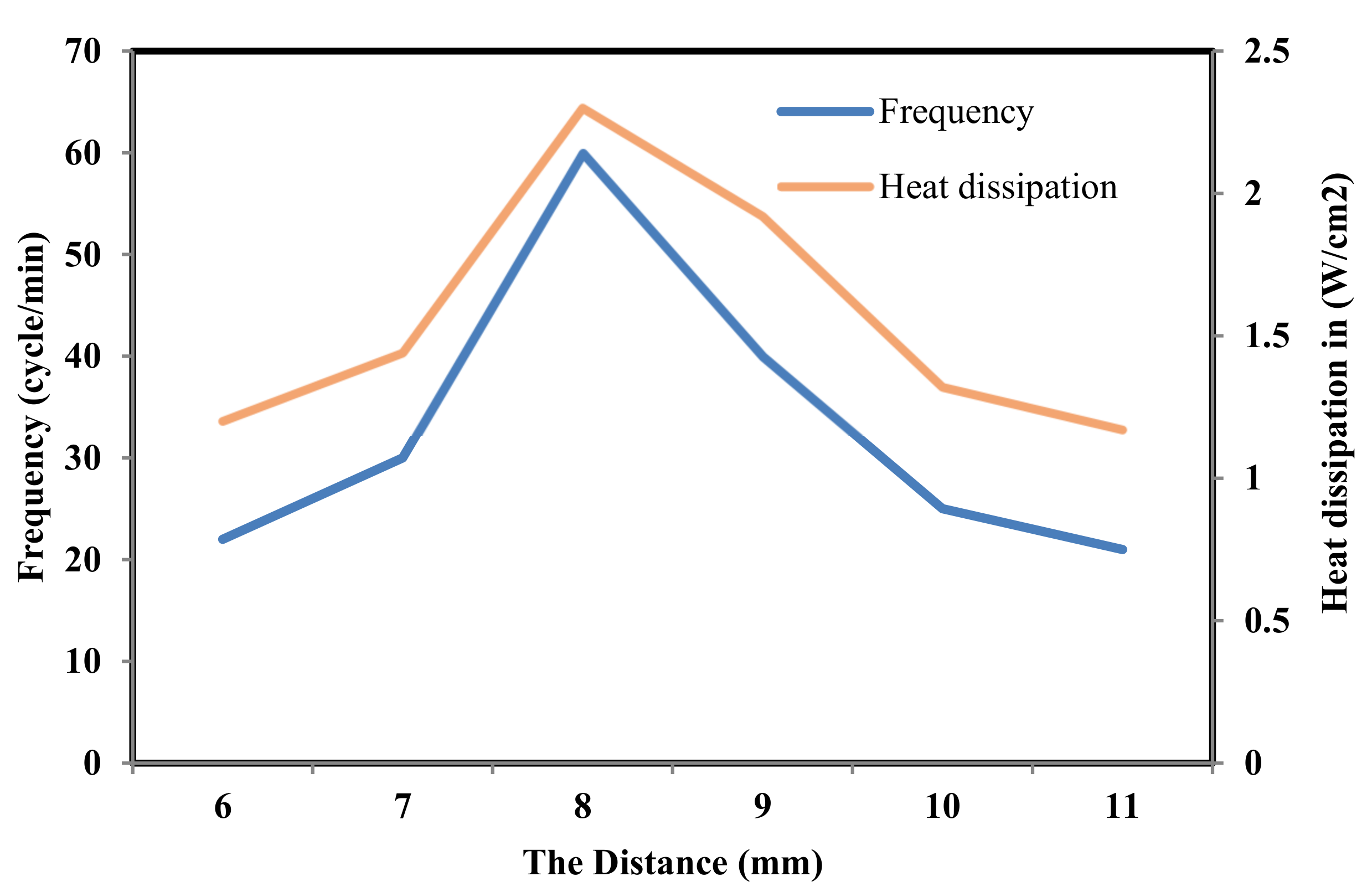
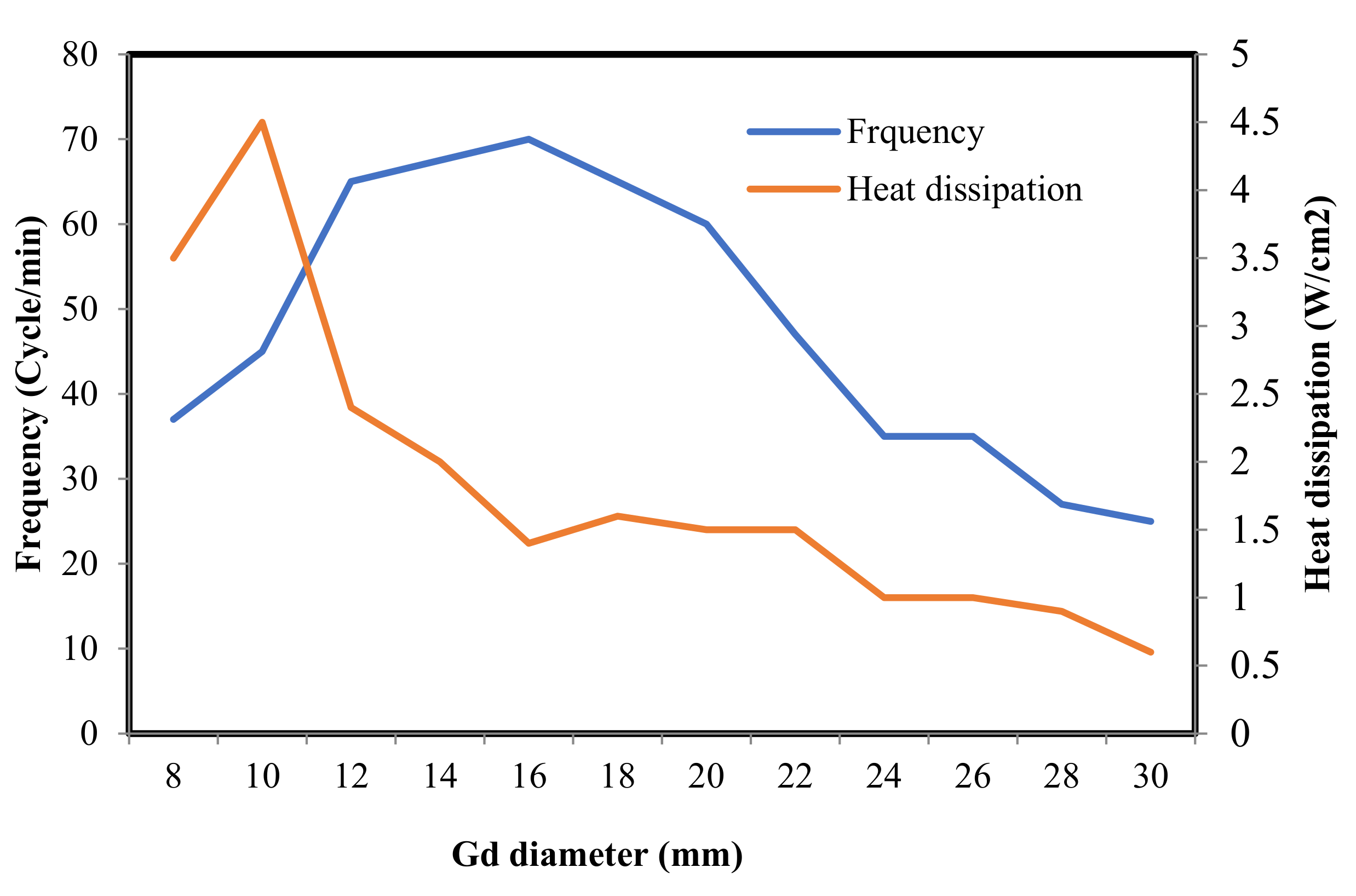
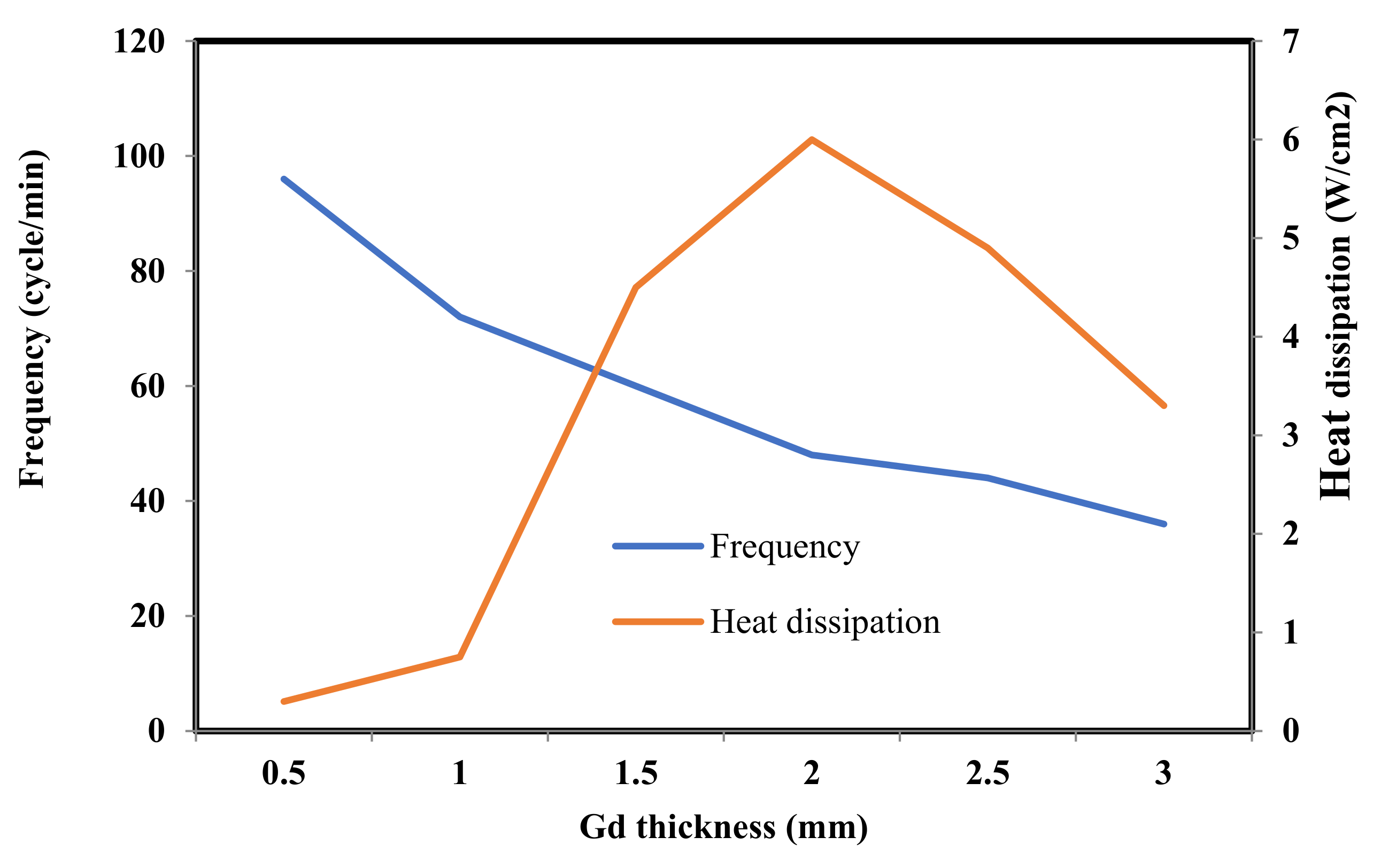
| Symbol | Values | Units | Description |
|---|---|---|---|
| K | 70 | N/mm | spring stiffness |
| W1 | 11 | mm | PM diameter |
| H1 | 10 | mm | PM height |
| W2 | 10 | mm | Gd diameter |
| H2 | 2 | mm | Gd height |
| W3 | 0.5 | mm | coil thickness |
| H3 | 10 | mm | distance between the heat source and heat sink |
| Heat source | 350 | k | heat source temperature |
| Heat sink | 280 | k | heat sink temperature |
| Coil | 25 | - | coil’s turns |
| M | 650,000 | A/m2 | PM magnetization |
| Category | Name | Expression | Unit | Description |
|---|---|---|---|---|
| Variables | F_net | Fz-F_g | N-m/m | Net force |
| M | intop1 (2*pi*1[cm])*d | kg | Gd mass | |
| F_g | M*g_const | N | Gravity force | |
| z_point | maxop1(z) | m | Gd’s initial position | |
| Fz | mf.Forcez_magnet | N | PM force | |
| m | 7.31g/(cm^3) | kg/m | Gd density | |
| K | 20 [N/m] | N/m | Spring stiffness | |
| Physics interfaces | Magnetic Fields (mf) | ― | ― | ― |
| Global ODEs and DAEs (ge) | ― | ― | ― | |
| Moving Mesh (ale) | ― | ― | ― | |
| Heat Transfer in Solids (ht) | ― | ― | ― | |
| Materials | Air (mat1) | ― | ― | ― |
| Permanent Magnet (mat2) | ― | ― | ― | |
| Gadolinium (mat3) | ― | ― | ― | |
| Aluminum (mat4) | ― | ― | ― | |
| Magnetic Fields (mf) features | Ampère’s Law 1 | ― | ― | ― |
| Axial Symmetry 1 | ― | ― | ― | |
| Magnetic Insulation 1 | ― | ― | ― | |
| Initial Values 1 | ― | ― | ― | |
| Ampère’s Law 2 | ― | ― | ― | |
| Force Calculation 1 | ― | ― | ― | |
| Continuity 1 | ― | ― | ― | |
| Coil 1 | ― | ― | ― |
| Symbol | Values | Units | Description |
|---|---|---|---|
| K | 70 | N/mm | spring stiffness |
| W1 | 11 | mm | PM diameter |
| H1 | 10 | mm | PM height |
| W2 | 10 | mm | Gd diameter |
| H2 | 2 | mm | Gd height |
| W3 | 5 | mm | coil thickness |
| H3 | 7 | mm | distance between the heat source and heat sink |
| Heat source | 350 | k | heat source temperature |
| Heat sink | 280 | k | heat sink temperature |
| Coil | 25 | - | coil’s turns |
| M | 650,000 | A/m2 | PM magnetization |
| Symbol | Frequency | Heat Dissipation | Both | Description |
|---|---|---|---|---|
| W2 | 16 | 10 | 11 | Gd diameter (mm) |
| H2 | 0.5 | 2 | 1.5 | Gd height (mm) |
| W3 | 2.5 | 2.5 | 2.5 | Coil thickness (mm) |
| H3 | 8 | 8 | 8 | Distance between heat source and heat sink (mm) |
| Heat Source | 310 | 330 | 315 | Temperature (K) |
| Heat Source | 260 | 270 | 262 | Temperature (K) |
Disclaimer/Publisher’s Note: The statements, opinions and data contained in all publications are solely those of the individual author(s) and contributor(s) and not of MDPI and/or the editor(s). MDPI and/or the editor(s) disclaim responsibility for any injury to people or property resulting from any ideas, methods, instructions or products referred to in the content. |
© 2024 by the authors. Licensee MDPI, Basel, Switzerland. This article is an open access article distributed under the terms and conditions of the Creative Commons Attribution (CC BY) license (https://creativecommons.org/licenses/by/4.0/).
Share and Cite
Homadi, A.; Sarhan, A.A.R. Enhancing Energy Efficiency of Thermomagnetic Generators: A Comprehensive Study on Frequency and Heat Dissipation. Mathematics 2024, 12, 1222. https://doi.org/10.3390/math12081222
Homadi A, Sarhan AAR. Enhancing Energy Efficiency of Thermomagnetic Generators: A Comprehensive Study on Frequency and Heat Dissipation. Mathematics. 2024; 12(8):1222. https://doi.org/10.3390/math12081222
Chicago/Turabian StyleHomadi, Abdulrahman, and Abd Alhamid Rafea Sarhan. 2024. "Enhancing Energy Efficiency of Thermomagnetic Generators: A Comprehensive Study on Frequency and Heat Dissipation" Mathematics 12, no. 8: 1222. https://doi.org/10.3390/math12081222
APA StyleHomadi, A., & Sarhan, A. A. R. (2024). Enhancing Energy Efficiency of Thermomagnetic Generators: A Comprehensive Study on Frequency and Heat Dissipation. Mathematics, 12(8), 1222. https://doi.org/10.3390/math12081222





